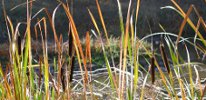
Training
Santa Cruz Long-Toed Salamander Workshop 2010
COST: $200.00
Payable by check to Elkhorn Slough Foundation
REGISTRATION FOR THIS PROGRAM IS CLOSED
Instructor Information
David Laabs
Wildlife Biologist
Center for Natural Lands Management and Biosearch
Dr. Wesley Savage
Department of Biological Sciences, University of Massachusetts
Contact
Grey Hayes
grey@elkhornslough.org
(831) 274-8700
Sponsors
Description
See also: Santa Cruz Long-Toed Salamander, Habitat Restoration
The Elkhorn Slough Coastal Training Program announced the Santa Cruz Long-Toed Salamander 2010 Workshop for 8:30-3 p.m., May 5, 2010 at the Elkhorn Slough National Estuarine Research Reserve. Intended audiences included: biological consultants, land managers, researchers, and regulatory agency personnel.
Workshop registration also included attendance at one of two field training sessions offered either 4:30-8 p.m. May 5, 2010 or in the morning of May 6, 9 am -1 pm at a location TBD.
Workshop Objectives: This was a great opportunity to gain an understanding of the biology of the Santa Cruz long-toed salamander and also how this information can be applied to habitat management for this species. The information conveyed will be useful in large-scale and local conservation planning efforts. Topics discussed included: the geographic distribution of Santa Cruz long-toed salamanders and related species, upland and aquatic habitats and their management, movements, population and community ecology, survey methods, and methods for assessing potential project impacts and approaches for avoidance and minimization. Participants received field training in species identification, sampling techniques, and habitat requirements of the Santa Cruz long-toed salamander.
Workshop Format
Wednesday May 5, 8:30-3:00 – Classroom: Wesley Savage and David Laabs presented a comprehensive lecture on the biology and conservation of the Santa Cruz long-toed salamander (Ambystoma macrodactylum croeceum, a.k.a. “SCLTS”). They explained key elements of SCLTS ecology, including life cycle (breeding clutch size, development time); habitat (breeding, juvenile, & adult), and; relationships with other species. They also discussed the complexities of conserving populations in increasingly fragmented landscapes in the range of SCLTS. As is typical for Coastal Training Program events, the workshop presented opportunities for structured question and discussion periods.
Wednesday May 5, 4:30-8 p.m. or Thursday May 6, 9 am -1 pm – Field Session: Wesley Savage presented habitat assessment and survey techniques at a location supporting the species. Movement patterns, identification protocol, and habitat management techniques were also be discussed.
Workshop Instructors
Wesley Savage: Dr. Savage is one of the leading researchers and advisors with expertise in the ecology, replicas bolsos life history, and conservation of this highly endangered species. His research focuses on population structure and evolutionary relationships in the long-toed salamander species complex. His current work involves linking population genetic structure with conservation strategies, focusing on salamander species that occur in fragmented landscapes. Since 2002 he, has worked extensively in the field with the Endangered Santa Cruz long-toed salamander to identify and sample breeding populations, and to estimate migration rates.
David Laabs: Mr. Laabs is the Preserve Manager of the Seascape Uplands Santa Cruz Long-Toed Salamander Preserve for the Center for Natural Lands Management. Since 1998, he has overseen the implementation of a Habitat Conservation Plan for the project, including annual monitoring of the resident long-toed salamander population. Mr. Laabs is well known for his rigorous scientific approach to managing for the salamander, as well as for the wealth of his data and knowledge on the species.
Documents and Publications
Contact List
We encourage participants to download the contact list to assist with arranging a rideshare or to get in contact with someone you met at the
workshop. Those interested in sharing a ride to the event are marked on the contact list.
Questions and Answers
Submit a question on this subject and we'll provide an answer. coastaltraining@elkhornsloughctp.org
